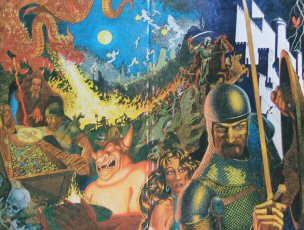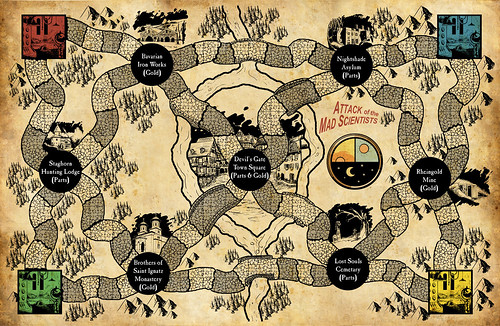 It may seem odd to illustrate a comment on Takuan Soho's The Unfettered Mind with an image painted by Miyamoto Musashi, given that Soho is billed on the front cover of this Wilson translation as "Writing to Yagyu Munenori, Musashi's great rival", but when I read Soho's piece on "Sever the Edge between Before and After" I immediately thought of this image.
It may seem odd to illustrate a comment on Takuan Soho's The Unfettered Mind with an image painted by Miyamoto Musashi, given that Soho is billed on the front cover of this Wilson translation as "Writing to Yagyu Munenori, Musashi's great rival", but when I read Soho's piece on "Sever the Edge between Before and After" I immediately thought of this image.Steph also brought this piece to mind in a discussion recently about taking action, recalling the decisive stroke that forms the body of the branch the shrike here is sitting on. That stroke is so full of boldness and uncompromising direction, giving life to the concept of "severing the edge" as I understand it. Soho writes:
This [severing the edge] means one should cut right through the interval between previous and present. Its significance is in cutting off the edge between before and after, between now and then. It means not detaining the mind.
Soho's text echoes with meaning for me, even knowing as I do how the English translation must necessarily strip layers of richness and allusion from the original. But this idea, of severing the connection between past and present, resonates especially.
Musashi's line in this image admits no indecisiveness, no clinging to possibilities. Because it seems to me that indecisiveness is just that -- an inability to let go of past truths and untruths, to choose a single present and commit to it fully. If we sever the past from our present, we are left with only the present moment, and we can act with full intention and focus.
In Katori Shinto Ryu, when I practice maku-uchi men, it is this total presence that I am trying to achieve. My aikido instructor Sensei Skoyles used to say that iai practice was all about "cutting away at ourselves", ridding ourselves of weaknesses or failures to seek victory over ourselves. Every cut is an opportunity to loose failure, to let fears and anxieties fall away. Every cut is a chance for perfection, but perfection can only exist in this moment, never in the past where we are powerless to act.
When I raise my sword over my head, I try to release all thoughts, to let my mind move as it must and simply make the cut, fully present and fully engaged, holding nothing back.
It is very very difficult, but not nearly as difficult as doing it WITHOUT the sword. For the true value of this practice is learning to act with such presence and focus in my day-to-day life. Katori shows me a way to be but it is up to me to use that vision and apply it to the rest of my life.

 DM screens are a staple of many game systems, and even though I rarely have papers or anything I want to hide from my players, I love those folding cardstock thingummies. One of my favourites of recent years is
DM screens are a staple of many game systems, and even though I rarely have papers or anything I want to hide from my players, I love those folding cardstock thingummies. One of my favourites of recent years is 




 Stuff is slowly but surely coming together. And by "stuff" I mean "awesome stuff".
Stuff is slowly but surely coming together. And by "stuff" I mean "awesome stuff". I'm reading Jono Bacon's "The Art of Community" which is helping concretize my ideas around what needs doing, and it's just getting me all the more excited.
I'm reading Jono Bacon's "The Art of Community" which is helping concretize my ideas around what needs doing, and it's just getting me all the more excited.
 Okay, I don't want to say too much about this just now, and I CAN tell you that certain details here are already due to change, but look, there's a piece of the puzzle, okay?
Okay, I don't want to say too much about this just now, and I CAN tell you that certain details here are already due to change, but look, there's a piece of the puzzle, okay?

 Ever since I first cracked open a copy of The Hobbit and The Book of Three (probably my two first real forays into fantasy fiction) I've been impressed with the power of a good map to deliver an important part of the experience. I used to spend hours looking over the large, fold-out map that came with my first copy (now lost, sadly) of Unfinished Tales, and wondering what those other, obscure places that Tolkien never really mentions in the narrative were like. Sea of Rhûn? Huh? Khand? What kind of place is that? Minhiriath? Tharbad? Cardolan?
Ever since I first cracked open a copy of The Hobbit and The Book of Three (probably my two first real forays into fantasy fiction) I've been impressed with the power of a good map to deliver an important part of the experience. I used to spend hours looking over the large, fold-out map that came with my first copy (now lost, sadly) of Unfinished Tales, and wondering what those other, obscure places that Tolkien never really mentions in the narrative were like. Sea of Rhûn? Huh? Khand? What kind of place is that? Minhiriath? Tharbad? Cardolan? This past August, I was fortunate to be able to join with Weins Sensei and others at his dojo in St Catherines, to practice and study with Sozen Larsen Kusano Sensei, of
This past August, I was fortunate to be able to join with Weins Sensei and others at his dojo in St Catherines, to practice and study with Sozen Larsen Kusano Sensei, of 
 The world is getting positively crowded with folks who do great things and don't try to squeeze every possible cent out of their audiences. Not that dancers and comic-book artists shouldn't get paid -- Cunningham has all sorts of links, thoughts and
The world is getting positively crowded with folks who do great things and don't try to squeeze every possible cent out of their audiences. Not that dancers and comic-book artists shouldn't get paid -- Cunningham has all sorts of links, thoughts and 







 Shugo is the classic ninja: stealthy, skilled and deadly. Well, one day, maybe, he'll be deadly. Right now he's going to have to settle for two out of three. As our first example of the
Shugo is the classic ninja: stealthy, skilled and deadly. Well, one day, maybe, he'll be deadly. Right now he's going to have to settle for two out of three. As our first example of the 